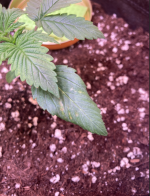Hello cannabis aficionados!
I am once again back at it, with the same motivation that I began with and a heart full of joy that grows alongside the plant. However there is, as I'm a beginner still some damage to contend with. I have planted three new plants and they are doing quite well. Today the one that was winning in terms of growth started showing some damage and I am not sure whether it is a nutrient based one.
What does it look like to you? Any help is appreciated greatly!
I am once again back at it, with the same motivation that I began with and a heart full of joy that grows alongside the plant. However there is, as I'm a beginner still some damage to contend with. I have planted three new plants and they are doing quite well. Today the one that was winning in terms of growth started showing some damage and I am not sure whether it is a nutrient based one.
What does it look like to you? Any help is appreciated greatly!



